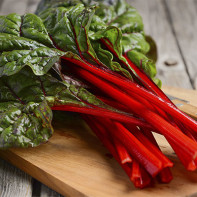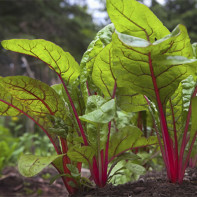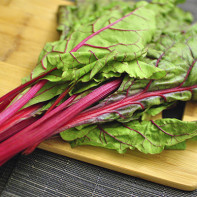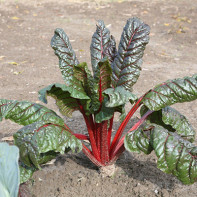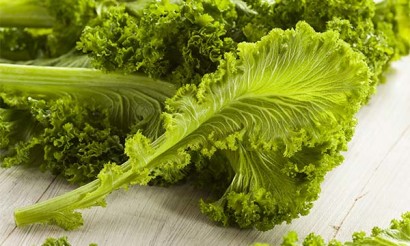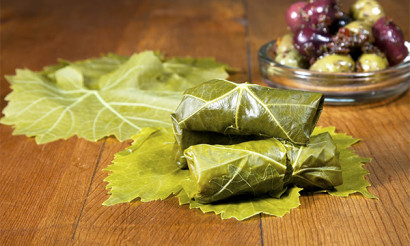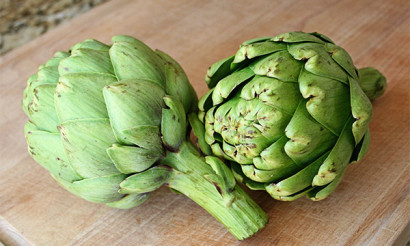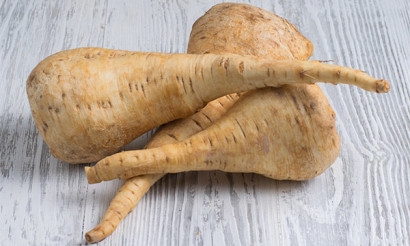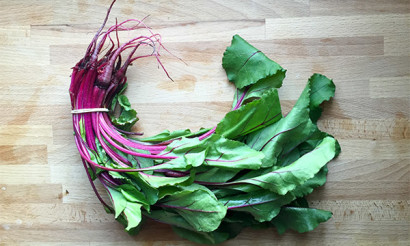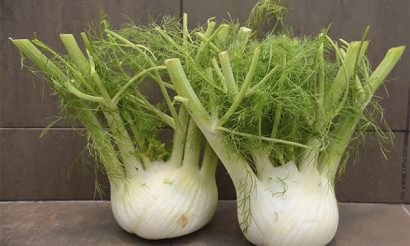Swiss chard: what it is, useful properties and contraindications.
Swiss chard has only relatively recently begun to gain popularity in Russia, but in Europe for a long time, more than a hundred years, enjoys success among many people (and not only followers of healthy eating).
- What is chard?
- Types
- Composition and calories
- Useful properties of chard
- For Women
- For Men
- During Pregnancy
- Breastfeeding
- For children
- For weight loss
- Benefits and uses of leaves
- Cancer
- Heart Disease
- Diabetes
- Digestive Problems
- Swiss chard in traditional medicine
- For Headaches
- For sore throat
- Immunity Enhancer
- Benefits for the circulatory system
- For better eyesight
- Chard Potion
- Chard in Cosmetology
- Skin wash for inflammation
- Dry Skin Mask
- Moisturizing Mask
- Anti Pigment Spots
- Strengthening Hair Mask
- Hazards and Contraindications
- How to choose and store Swiss chard
- Can I Freeze it?
- How to Eat Swiss chard
- What can be cooked with chard: Recipes
- Salad with Swiss chard
- Easy side dish for pork steak
- Custard pasta with greens
- Pickled Chard Stalks
- Interesting Facts about Chard
The first official appearance of the vegetable in dishes is attributed to the largest island in Italy, Sicily. This is why chard is often seen as an ingredient in many Italian dishes. It is used in salads, stewed with vegetables, and cooked in soups. Many people note its subtle bitterness in its raw form. When it is cooked, it disappears and a subtle and mild flavor appears, more appetizing than that of spinach.
What is chard
Chard is better known to many as a leafy beet and differs from our usual table beet only in the fact that it is not the root vegetable, but the leaves and stems themselves that are consumed. In spite of this, chard is a vegetable; it has a thick, crunchy stem and smooth leaves.

The stem comes in a variety of colors, from the familiar green to bright red and burgundy. It is by the stem that you can determine the type of vegetable.
Types
There are a great many species of chard. Conventionally, they are divided into leafy and petiolate.
- The leafy ones (they are also called Roman cabbage) have large fleshy leaves, to the taste they resemble spinach. This species can easily replace common lettuce, cabbage, and other leafy counterparts.
- The petiole chard has small leaves, but the stem is very thick and juicy. It is what gets sliced into salads or used in vegetable stews.
There are basically three varieties of chard that are most popular in the trade:
- With red stems are ruby (red) chard.
- With white stems, sometimes with a yellowish hue, is white chard (less commonly referred to as yellow).
- Rainbow variety - this is certainly not a particular species, it is more like a composite of all the others - yellow, emerald, silver and scarlet - such a colorful assortment will decorate any salad on the holiday table.
Composition and calories
The leaves and stems of the chard are an abundance of useful substances. This is a large number of vitamins, which are contained in 100 grams of vegetable. They can not just cover the daily norm, but even exceed it - vitamins A and K. Chard is also not inferior in vitamin C content to lemon or orange. This bright vegetable is a good source of useful micro- and macronutrients - magnesium, calcium, phosphorus, sodium and many others.
Like any vegetable product, leafy beets are rich in dietary fiber. It is high in antioxidants and phytonutrients, which are unique in their own way and very healthy. And all this lies under the low-calorie shell - only 20 kcal per 100 grams. Therefore, this vegetable is useful for all thinners and support a healthy lifestyle people.
Useful properties of chard
For women
All the nutritional components, of course, are very useful for the human body, but a special joy for the weaker sex gives the chard thanks to its ability to improve the condition of the skin and hair. All thanks to its content of a special organic compound - biotin.
Biotin improves the structure of hair, they become softer and less prone to breakage, there is a healthy shine. By stimulating hair follicles, biotin accelerates hair growth.
Lack of this compound can cause frequent rashes and inflammation of the skin. Therefore, the systematic use of chard will help improve the appearance of the skin, contribute to the appearance of a healthy glowing shade.
For men
Men, as the representatives of the stronger sex, need nutrients in a doubled quantity. That is why chard must be included in men's diets. A large amount of vitamin A promotes good cell renewal, selenium and zinc will help the normal production of testosterone, and all this together improves male strength and performance of the sexual system.
When pregnant
Pregnancy requires special attention to nutrition, so it is necessary to strictly follow what you can eat and in what quantity. The diet should be rich in useful components that are necessary for the proper development of the fetus - it is protein, calcium, iron, vitamins and minerals.
The presence of vitamins in the chard, some even in excess, will allow to get them not only for the mother, but also for the child, which will contribute to its health and normal growth. Vitamin C will strengthen the immune system of the future mother and protect her from viruses and bacteria. Iron will improve blood circulation, normalizing hemoglobin levels and reducing the risk of anemia.
Breastfeeding
The health of a breastfed baby directly depends on what foods are in the mother's diet and what they are rich in. Immediately after birth, the infant needs the intake of nutrients through the mother's milk.
The presence of beet leaves in the diet will provide your baby with phosphorus and calcium. This is a necessary component for the proper construction of the bone skeleton and musculoskeletal system as a whole. Sodium will regulate fluid and salt metabolism in the body, relieve the mother from swelling, improve the kidney function of the child.
For children
A child's body is subject to a large number of attacks from the outside world at a time when its nutrition is no longer dependent on mother's milk. Therefore, vitamins and minerals should come with food, it depends on the proper growth and development of the whole body. To protect the baby from disease, parents should make sure that the food contains enough vitamin C. Sour lemon is unlikely to be eaten by a child, but vegetable puree with the addition of chard is an interesting product, bright in color and neutral in taste. The presence of calcium in it will help the formation of bones and tendons during growth, and phosphorus - mental development and strengthening the bone skeleton.
When losing weight.
A healthy diet involves combining benefits and low calories for more successful results. The products included in the diet should contain all the nutrients the body needs, as well as give a feeling of satiety, even in small quantities. Leafy beets do a good job in this role. The high fiber content minimizes the risk of overeating and snacking, as this product can be quickly satiated. Consuming this vegetable improves the metabolism, which contributes to the rapid breakdown of fats.
It has been scientifically proven that people who include large amounts of vegetables in their diet are less likely to be overweight. If this problem already exists, they lose weight faster than those who restrict their food intake and starve their bodies.
Swiss chard is a good example of how to lose weight in a healthy and beneficial way.
The Leaf's Benefits and Uses
Due to its rich composition, chard is indispensable for the body in various diseases.
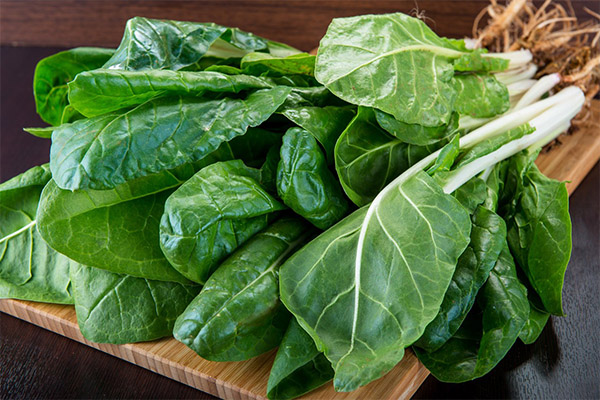
Cancer
The antioxidants of beet leaves are true fighters for human health. They can prevent the appearance of cancerous tumors arising from the presence of free radicals in the body, protecting cells from damage by them. Vitamins A and C help them do this.
Beta-carotene is also an immune stimulating substance. Its regular intake reduces the risk of lung cancer, and this is a scientifically proven fact.
Phenolic compounds found in chard direct their anti-inflammatory effect on pancreatic cancer cells.
Heart disease
The bioflavonoid vitexin will help in the fight against cardiovascular diseases. It can reduce blood pressure, normalize blood clotting. Kempferol also has a beneficial effect on blood vessels - it strengthens them and protects against blood clots. The presence of potassium can lower blood pressure and neutralize the enzymes that cause hypertension. From anemia and its symptoms (weakness and increased fatigue) will help iron and copper. They improve blood circulation and saturate the organs in the body with oxygen.
Thanks to these and many other components, eating chard can protect people from heart attacks and strokes.
Diabetes mellitus
In addition to dietary fiber, which maintains normal blood glucose levels, a flavonoid unique in its abilities, sirinic acid, was recently discovered in chard. It helps normalize blood glucose levels by acting on an enzyme that breaks down complex carbohydrates into simpler sugars. This is why it is very necessary in the diet of people with diabetes or those who are at risk of getting it. Antioxidants also help to improve the overall condition of patients, reducing the risk of complications associated with diabetes.
Consuming chard, like other leafy vegetables, has been shown to reduce the likelihood of diabetes.
Digestive Problems
Fiber is a kind of nutrition for intestinal microflora. It improves the peristalsis of the gastrointestinal tract, stabilizing digestion. Therefore, foods rich in fiber should be consumed by those who watch their figure or want to fix it. Swiss chard is exactly what promotes weight loss and normalization.
In addition, it improves:
- Brain function. Potassium improves brain function and assimilation of information by improving the delivery of oxygen to it, and vitamin K protects against many diseases and reduces fatigue.
- The vegetable also helps keep your eyesight normal. Beta-carotene and vitamin A minimize the risk of vision-related diseases - glaucoma, yellow spot degeneration and so on. They protect the cornea of the eye, keeping it in optimal condition.
Swiss chard in traditional medicine
In folk medicine, beet leaves are used both in "natural" form and in the form of decoctions. The latter are very popular because it is believed that the best effect on the body can be obtained through a hot beverage. This opinion is erroneous, because heat processing destroys many vitamins. For example, vitamin C is destroyed by 90% when boiled.
If you have headaches
For headaches, it is recommended to crush the leaves of the vegetable into a puree and apply to the temples or forehead for half an hour or an hour. You can use whole, unshredded leaves, plucked literally from the bed.
For a sore throat
This folk recipe is ideal for treating pharyngitis and other inflammatory processes in the throat. You will need 250 g of chard (preferably with juicy leaves and stalks) and 1 teaspoon of 9% table vinegar. Cut the vegetable into small pieces and add the vinegar to it. The resulting mixture is left for some time until the liquid is released from the beet leaves. Strain the resulting tincture through gauze and drink such a liquid in small quantities every 5 hours. For better results, you can add to the tincture the juice of a table beet.
With sore throat you can try the juice of the chard. It is enough to add various fruits (citrus fruits are better) for flavoring and use such a drink once a day for one glass.
To strengthen the immune system
To strengthen the immune system you will need 250 grams of chard, a couple of cloves of garlic and 1 teaspoon of vegetable oil. Chop garlic and chard, both components pour vegetable oil. The resulting puree can serve as a good preventive measure in cold weather.
Benefits for the circulatory system
The best results for the heart can be obtained by drinking chard juice. It lowers blood pressure and helps purify the blood.
The same chard juice can help stop bleeding. The actions performed are comparable to the use of plantain - you need to soak gauze in the juice and apply it to the wound. Also the presence of anti-inflammatory components relieves swelling around the wound.
To improve vision
Beta-carotene will be a salad of chard and carrots. For this, just chop 300 g of chard and grate 1 large carrot. If desired, you can add oil and spices. This is a healthy alternative to Korean-style carrots.
Chard Decoction.
A decoction, in fact, can help cure any ailment. It cleanses the liver well, acts as a diuretic, and replaces a fizzy vitamin C tablet when you have a cold. Also beet leaf helps to cope with stress by having a calming effect on the nervous system.
For the broth you will need 1 liter of water per 100 g of chard. Boil the vegetable in a pot with the lid closed for 20 minutes. It should be consumed before going to bed.
Mangold in cosmetology
The therapeutic effects of chard can be directed to improve the condition of the skin and hair.
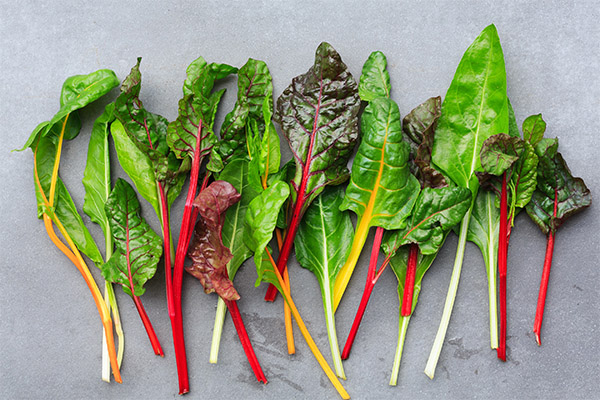
Skin cleansing liquid for inflammation
If painful pimples have appeared on the face, there is no need to despair. To cleanse the skin and get rid of hateful rashes, you need to remember folk recipes.
To dry and peculiar whitening of the skin is necessary to boil the leaves and petioles of chard, and after cooling the resulting broth add to the liquid 1 teaspoon of apple cider vinegar. The resulting water should just wash your face before going to bed. After a week inflammation will begin to fade, the skin will be much clearer.
Mask for dry skin
This mask can be used during the cold season, when the skin is chapped, or on hot days, when it lacks moisture and nutrition.
For the mask you will need 1 tablespoon of chard juice and 1 teaspoon of sour cream. Mix all the ingredients to a smooth thick consistency, apply the mask to the face and décolleté zone for 15-20 minutes, and then rinse off with lukewarm water.
Moisturizing mask
Add 1 tea spoon of honey and the same amount of olive oil to 300g finely chopped (or better pureed) mangold. Masque to put on your face and cleavage area for 15-20 minutes, then rinse with water and put a suitable cream on a clean skin.
Against age spots
Chard can also help to whiten skin from pigmentation. You can use vegetable puree or just scalded leaves with boiling water. Leave the leaves on the skin of the face for 15-20 minutes, then wash with warm running water. Such a remedy is good for freckles.
Strengthening Hair Mask
The juice of the chard will help with hair loss no worse than burdock or coconut oil. To do this, you need to rub it into the scalp at least 2 times a week. You can also make a nourishing mask based on the puree of chard and burdock oil. At 250 grams of vegetable add 3 teaspoons of burdock oil and rub the resulting mixture into the scalp, and then put a hat or a towel to create a "greenhouse effect. After half an hour, thoroughly rinse the mask with water and moisturizing balm.
Health Hazards and Contraindications
Any product with its health benefits can cause significant harm to the body if consumed very often. Chard with lots of fiber can cause stomach upset. It can manifest itself differently in everyone - some in the form of stagnation, and some are lucky with loosening.
The oxalic acid content of the vegetable can also play a cruel trick on those who have gastritis with hyperacidity. Salts, oxalates, contained in almost any leafy vegetable, worsen the condition with urolithiasis. Therefore, people with this problem, chard is contraindicated (as well as sorrel or table beets).
If you liked the chard juice and want to use it all the time, it is better to dilute it with carrot or tomato juices, because the concentrated beverage can cause bloating. For the same reason, you should not abuse it for people with gastritis or ulcers.
How to choose and store chard
When choosing chard, you should fully trust the organoleptic indicators - the appearance, color, smell and apparent juiciness of the product. The fresher the vegetable, the more beneficial properties will be obtained from it.

- Leaf color. The leaves of fresh chard are bright and juicy burgundy (ruby) or green (all other types of the vegetable). The appearance of freshness will indicate that the vegetable has not been on the counter for a long time.
- Smell. Chard should exude the aroma of fresh greens with a slight bitterness. If the smell is watery or there are other extraneous flavors - do not take such a vegetable. Even if it looks attractive, it probably will not last long in the refrigerator.
- The stem of the chard. The stem should not be flaccid. A flexible and thin stem indicates that the plant is young - such a leafy beet is great for salad. Juicy thick stem indicates that the vegetable is mature enough - it is good for preparing medicinal masks or decoctions. But to a salad, unfortunately, it will give bitterness.
- Leaf structure. The leaves should have a crunchy consistency comparable to lettuce: when you squeeze them with your fingers, you should feel a slight crackling sensation. Although this way of recognizing structure is not suitable for a young plant - its leaves are soft and delicate, but the size will also be correspondingly smaller.
- Absence of spots and voids on the leaf surface. White spots on the leaves usually indicate the use of pesticides or other chemicals in cultivation. Black spots are a sign that the vegetable is starting to rot. Voids usually mean that the leaves were a favorite food for insects.
- Packing. It is best to buy chard without packaging. A vegetable in a plastic bag will store less because of the accumulation of condensation inside.
It is better to store chard in a plastic container in the refrigerator. It should not be placed on a shelf under the freezer - this will not extend the shelf life. The best option would be to use the leafy beets immediately after purchasing them. If this outcome is not possible, the chard can remain in the refrigerator for up to 4 days. After this period, it will lose not only its attractive appearance, but also its useful properties. The rotting process will begin, which can play a bad joke on the body.
Another secret for storage, suitable for all vegetables: wash the chard only immediately before using it.
Can it be frozen
When frozen, you can preserve chard for up to four months. This kind of storage preserves nearly all the nutrients, and you can store the vegetable for future use. You should also freeze it in plastic containers, avoiding the use of bags.
How to eat Swiss chard correctly
The flavor of fresh, unprocessed chard resembles spinach. For the most part, it is neutral and has a slight pleasant bitterness. This flavor will add a spicy touch to any dish. The taste of the vegetable is also affected by its initial processing before use.
- It is necessary to thoroughly wash the vegetable from visible impurities in warm water. It is advised to do it even 2-3 times.
- Be sure to inspect the bunch of greens for spoiled leaves - their specific taste will significantly spoil the dish.
- When cooking it is necessary to drain the first decoction, because it can contain a lot of harmful substances (such as nitrates, actively used in leafy crops). This rule does not apply if the chard was grown in its own bed.
- If there is a problem called gastritis, and you really want to try the vegetable, you should try cooking it with the addition of dairy products - they will neutralize the acids.
What can be cooked from chard: recipes
Salad with chard leaves
The easiest way to prepare chard is to add it to a salad. It can consist of a mixture of different greens - for example, spinach, arugula, lettuce and Peking cabbage.
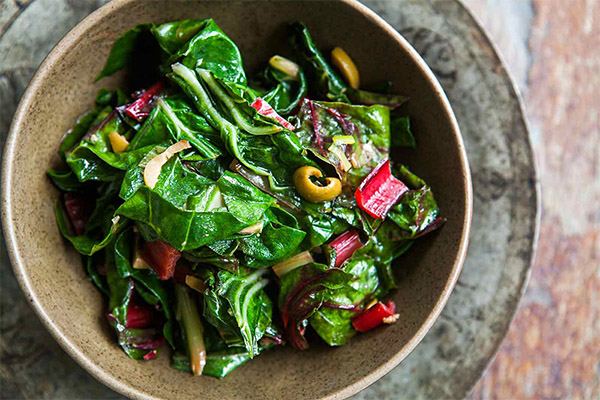
One popular and simple salad recipe will need the following ingredients:
- Mangold leaves - 800 g;
- croutons or bread crumbs - 20 g;
- cucumber - 5 medium sized pieces;
- cherry tomatoes - 5 pcs;
- Caesar sauce - 1-2 tbsp.
Cut cucumbers into small slices, cherry tomatoes into slices. Chop the chard leaves by tearing them with your hands. Mix the ingredients, season with salt and pepper to taste. You can add brine cheeses to the salad.
Easy side dish for pork steak
At the time of flowering greenery we want to treat ourselves to an unusual side dish of what grows in the garden. For such a side dish you will need the following products:
- Swiss chard - 300 g;
- garlic cloves - 300 gr;
- vegetable oil - 1 tsp;
- Salt, spices - to taste.
Rinse the vegetable components thoroughly with warm water, then cut into large pieces. Mix all the ingredients with salt and spices in a bowl, then place in a well-heated frying pan with vegetable oil. Fry the chard and garlic, stirring constantly to prevent them from burning. Readiness can be determined by the garlic shoots - the color will become darker, and the structure - soft. If desired, you can dress with sauce.
Cheese pasta with greens
Pasta is easy to make at home. For the price it will be much cheaper than if you buy in the store. To prepare it you will need the following ingredients:
- cottage cheese 5% fat - 200 g;
- chard - 50 g;
- garlic - 1 clove;
- Sour cream - 1 tbsp.
To soften the chard should be previously stewed in a pan with the addition of water for 10 minutes. After all the components grind in a mixer to the desired consistency. A more liquid texture can be obtained by adding more sour cream.
Pickled Chard Stalks
This is quite an unusual dish, but at the same time a great way to extend the shelf life of the chard.

To prepare the marinade, you will need the following ingredients:
- water - 1 l;
- sugar - 50 g;
- salt - 50 gr;
- vinegar - 250 ml.
Its preparation is very simple - add salt, sugar and vinegar to boiling water.
Preparing the canning
Cut the chard stalks to 5-6 cm in size and blanch in boiling water for 5 minutes. Cooled cuttings distribute in sterilized jars. Pour hot marinade into jars, cover and set aside in a dark cool place to cool. Store pickled chard in the refrigerator for 1 month, during which time you can always serve a crunchy snack to the table (no worse than cucumbers).
You can also pickle chard leaves. The marinade preparation technology is no different, but the leaves themselves do not need heat treatment - they are quite capable of softening the marinade.
In this case, the leaves are not cut, but rolled up a few at a time. In this form, they should be carefully placed in a jar and poured with marinade. In a salad, few people will taste such leaves, but for the preparation of heat-treated dishes, such as soups and pies, quite.
Other Ways to Use Chard in Cooking
- Chard leaves and stalks can be used to make a smoothie with carrot juice. The healthy drink will give you a boost of energy in the morning and a complex of useful substances for the whole day.
- Chard leaves can be replaced by spinach in many dishes - the taste will not change much. For example, stuff a chicken breast with cheese.
- You can try to make chips out of its leaves. You need to cut them into small pieces, splash them with oil, sprinkle them with salt and other desired spices and bake them until they are crisp and crunchy.
- Often chard is added to the pie along with a hard-boiled egg and other herbs.
Interesting Facts about Chard
- Due to a certain resemblance in appearance, chard is often confused with spinach and vice versa.
- As far back as ancient times, chard was used to treat blood infections, fevers and other infections.
- It does not tolerate the neighborhood on the bed of their own kind - cabbage, beets and spinach. All the useful properties in this case in the chard are reduced.
«Important: All information on this site is provided solely for introductory purposes only. Before applying any recommendations, consult a specialist specialist. Neither the editors nor the authors are liable for any possible harm caused by materials."

